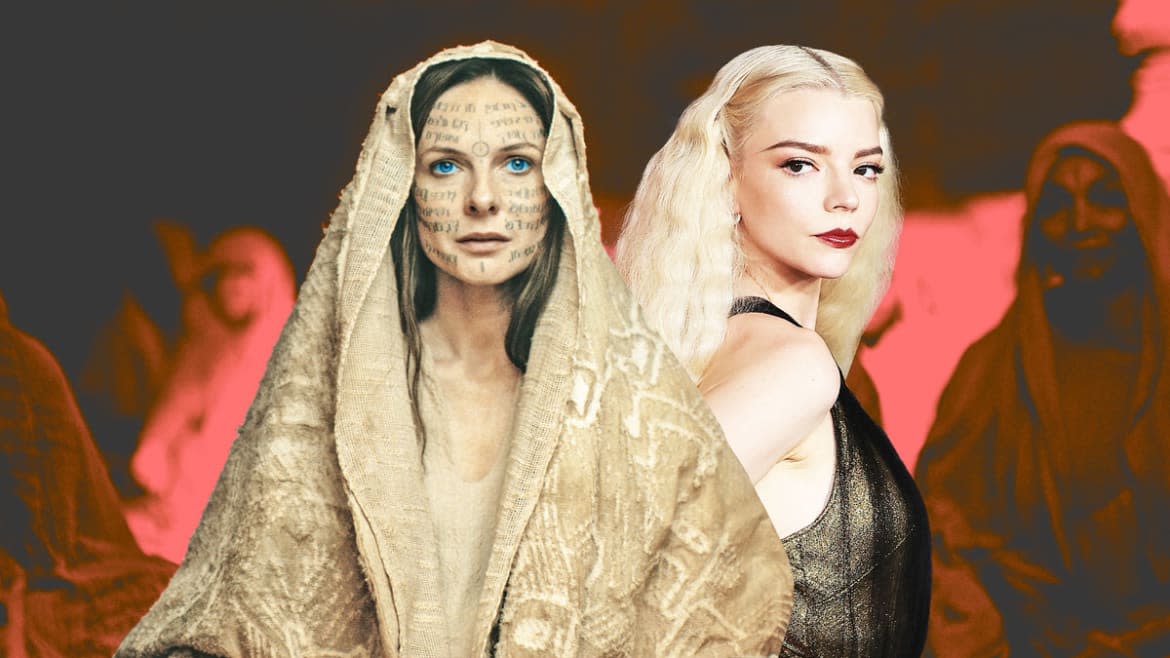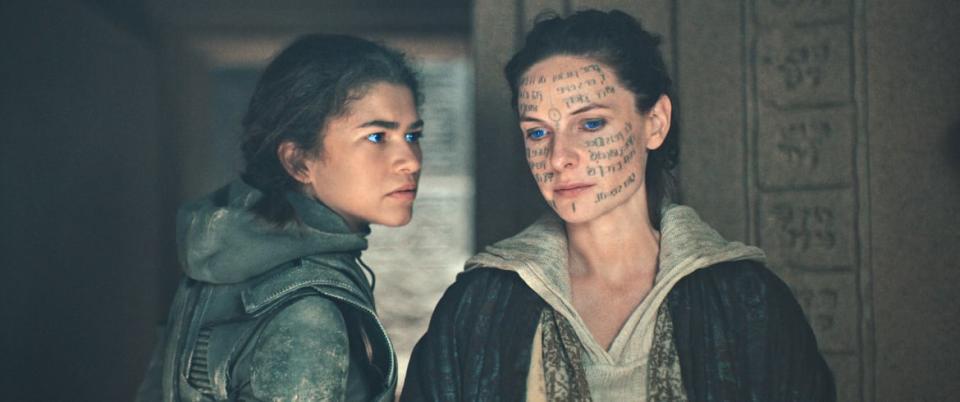The Talking Fetus—and Wild Cameo—in ‘Dune: Part Two,’ Explained

- Oops!Something went wrong.Please try again later.
- Oops!Something went wrong.Please try again later.
- Oops!Something went wrong.Please try again later.
(Warning: Spoilers for Dune: Part Two and for Frank Herbert's second Dune novel, Dune: Messiah ahead.)
In the opening moments of Dune: Part Two, a new character is introduced to Denis Villeneuve's sandy saga. No, I am not referring to a fierce Fremen warrior, nor am I speaking of a stony-faced Bene Gesserit. This character is much, much younger— and much more jarring. I am, of course, talking about Dune’s talking fetus.
Filmmakers can’t seem to get enough of unborn fetuses these days. We all remember the horrifying abomination that appeared in Andrew Dominik’s Blonde two years ago. Like Dominik, Villeneuve frames his film’s fetus as an actual character: Rather than simply showing a mother-to-be speaking to her belly, both directors show the fetuses themselves floating around in their dark, eerie wombs as creepy, childlike voices echo out.
However, although the talking fetus of Dune initially feels like something of a jumpscare (especially after the horrors of Marilyn Monroe’s chatty fetus), Villeneuve’s take on this bizarre filmic trope is, it turns out, both justified and surprisingly effective from a storytelling perspective. Ultimately, the very real presence of a talking fetus in the film foreshadows the power and the narrative importance of Alia Atreides. It also helps to explain why Anya Taylor-Joy flashes unexpectedly onto the screen three-quarters of the way through the film.
The Gigantic, Glorious ‘Dune: Part Two’ Squishes Other Epics Like Ants
To understand why this fetus is talking and why Anya appears out of the blue, we have to go back a little. In the first film, we learn that Jessica (Rebecca Ferguson) is a member of the Bene Gesserit, a sci-fi sisterhood of supernaturally gifted women who hone their abilities to predict and sway the tides of power across the galaxy. Long ago, the Bene Gesserit predicted the rise of a “Kwisatz Haderach.” The Kwisatz Haderach would be the male son of a Bene Gesserit, who, after 10,000 years of careful breeding, would be able to access generations of Bene Gesserit memories. Over the course of the two Dune films, Paul (Timothée Chalamet), Jessica’s son with the assassinated Duke Leto Atreides (Oscar Isaac), begins to look more and more like the Kwisatz Haderach that was promised. Not only does Paul possess unique Bene Gesserit abilities, but his mother also turns out to be the daughter of Baron Harkonnen (a blob-ified Bill Stellan Skarsgård). In other words, Paul has ancestry from House Atreides, House Harkonnen, and the Bene Gesseri—a very powerful combination indeed, especially considering the fact that, by the end of the first film, Paul is the only survivor from House Atreides.
However, at the end of Villeneuve’s first Dune installment, we discover that Jessica is pregnant with a daughter. This means that there will be another child who shares Paul’s powerful ancestry. This child appears in Frank Herbert’s later novels as Alia Atreides, and she is just as compelling and powerful as her ancestry would suggest.
But unlike Paul, Alia is born after Jessica drinks the Water of Life, a substance that gives her the "sight" of generations of Bene Gesserit past, present and future. The Water of Life is also consumed by the unborn Alia—and so, the young child is born with immense Bene Gesserit wisdom.
Although Jessica doesn’t give birth to Alia during the second Dune film, the presence of Alia is vital to her and her son’s journeys. In fact, so great are Alia’s Bene Gesserit powers, she is able to communicate with her mother from the womb; she guides her, warns her, influences her. Within the supernatural conceit of the Bene Gesserit, the conversations between mother and unborn daughter are very real. As such, physically seeing and hearing the fetus speak provides some much-needed narrative clarity when it comes to Jessica’s trajectory and motives throughout the second film.

Lady Jessica has fully tuned Chani (Zendaya) out to listen to her fetus.
The physical presence of fetus-Alia serves another purpose, too: It means that Alia looms over the entire film, an ominous power-to-be. By seeing and hearing her speak to her mother, we realize just how influential a character Alia will be when she is actually born.
This, of course, brings us to the Anya Taylor-Joy of it all. For people unfamiliar with Herbert’s sprawling series, the sudden appearance of Taylor-Joy gazing into the camera on a beach may very well be confusing. However, it kind of makes sense within Villeneuve’s established dramaturgical language. It has been well-established that Paul, thanks to his Bene Gesserit roots, has visions of the future. In the first film, he frequently saw Chani (Zendaya) floating around in slow-motion in his dreams. In the second film, many of those visions have come to pass. So, the sudden appearance of a grown-up Alia (Taylor-Joy) is not really any different; it is a glimpse of what is to come for Paul. In the vision, she warns her brother about his complicated future. She also breaks the news that their mother is the daughter of Baron Harkonnen.
Now, this is some artistic license on the part of Villeneuve. In the novel, Paul doesn’t have visions of Alia. Plus, Alia is actually born during the events of the first novel; in the book, there is a time jump, and she is the one who kills the Baron, not Paul.
Villeneuve made a narrative choice to condense the events of the first Dune novel. Instead of showing us a precocious child Alia, he kept her as an ominous promise of what is to come—and thus, we see her only as a creepy prescient fetus and an eerie, ghostly vision.
“It came out of screenwriting discussions with Jon [Spaihts], when we were trying to figure out how to increase tension and create more momentum in the story,” Villeneuve told Entertainment Weekly of the decision. “To put more pressure on Paul, we decided to compress time. We had this idea that we could create the feeling of the progression of time through Jessica’s pregnancy… Having her talk to her fetus was a way to illustrate the power of the Water of Life, this substance that gives you access to the past lives of previous Reverend Mothers. It was a way to more precisely express how Alia becomes this abomination.”
The 7 Greatest TV and Movie Do-Overs, From ‘Dune’ to ‘Deadpool’
Does this mean that Taylor-Joy will feature prominently in the next Dune film? Maybe. In the novels, Alia doesn’t appear as an adult until the third book, Children of Dune; Villeneueve has already confirmed that a potential third film would follow the events of the second novel, Dune: Messiah, during which Ali is a young teen. But who knows— perhaps Villeneuve will perform some more narrative time-bending magic in his next adaptation.
I am still, as a rule, not a fan of speaking fetuses on film. For one thing, they are, quite simply, creepy. And, as Blonde proved, they have the potential to be politically questionable. However, with the promise of a fascinating arc for Alia Atreides in films to come, Dune: Part Two is the exception to the rule.
Get the Daily Beast's biggest scoops and scandals delivered right to your inbox. Sign up now.
Stay informed and gain unlimited access to the Daily Beast's unmatched reporting. Subscribe now.

